Dive Brief:
-
Nestlé UK & Ireland and Cargill are experimenting with a low-carbon fertilizer made from cocoa shells discarded from a chocolate factory, part of both food giants' efforts to advance regenerative agriculture.
-
The companies plan to test the fertilizer on a couple of farms that supply wheat for Nestlé in the UK. The cocoa shells will come from a confectionary site in York, and the companies will evaluate the fertilizer's impacts on crop production and soil health, as well as its ability to reduce greenhouse gas emissions.
-
If successful, up to 7,000 metric tons of the cocoa-based fertilizer — or a quarter of Nestlé's conventional fertilizer use for wheat — could be used by farmers in Nestlé’s supply chain.
Dive Insight:
More than 5% of global greenhouse gas emissions are linked to the production and use of conventional fertilizers, according to researchers from Cambridge University. Recycling nutrients from food waste, though, has the potential to lower emissions and could result in a more sustainable product that farmers can get at a reliable price.
“This project is a small, but very meaningful step towards a net zero future, where farmers, local enterprises, and nature all stand to benefit,” Matt Ryan, regeneration lead at Nestlé UK & Ireland, said in a statement.
The cocoa shells, supplied by Cargill, are processed at a facility for ingredients in chocolate treats like Kit Kat and Aero. The two farms supply wheat to Nestlé factories producing breakfast cereals and pet foods.
With help from Swindon-based Ccm Technologies, a company that captures carbon dioxide, ammonia and phosphates from food and water waste, an undisclosed trial amount of cocoa shells has been transformed into fertilizer pellets.
The trials are taking place on arable farms in Suffolk and Northamptonshire, where the test fertilizer has been applied alongside its conventional counterpart. The project is overseen by York-based Fera Science Ltd., who is evaluating factors like wheat yield and quality, soil biodiversity and emissions output.
This collaborative effort builds on Nestlé and Cargill’s sustainability goals and commitments to reducing the companies’ carbon footprints. Cargill is working toward zero-carbon shipping by 2050, while Nestlé is experimenting with ways to achieve net zero emissions by 2050.
The Swiss multinational company is also committed to sourcing 50% of its ingredients from regenerative agricultural methods by 2030.
More than half of wheat’s carbon footprint in the UK is due to fertilizer use, according to Nestlé. If successful, the test pellets could replace about 25% of Nestlé UK’s total fertilizer use for wheat.
Richard Ling, farm manager at Rookery Farm, Wortham in Norfolk, said in a statement that he has just finished harvesting a successful Winter Wheat crop using the cocoa-based fertilizer and found no significant difference between the test and control groups.
“We are really reassured with the results and are looking at running further trials,” said Ling, who supplies crops for Nestlé’s Purina brand.











